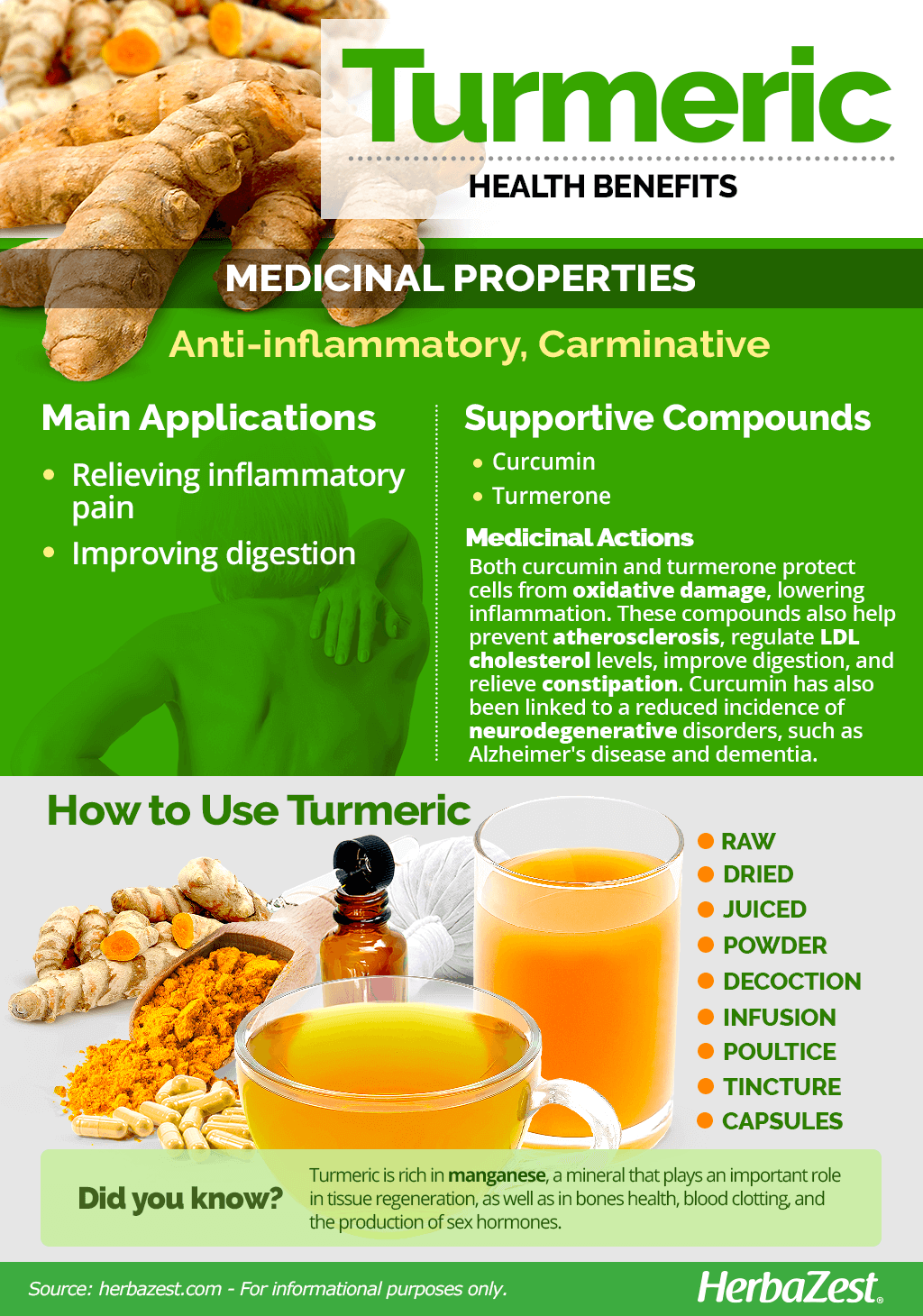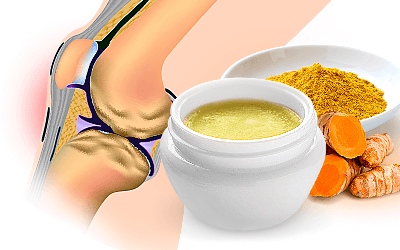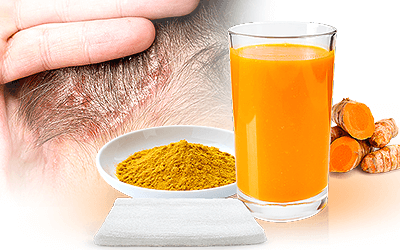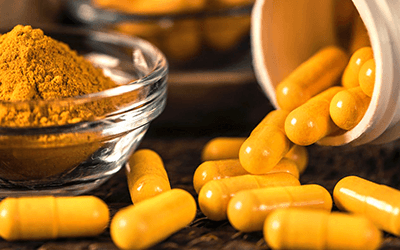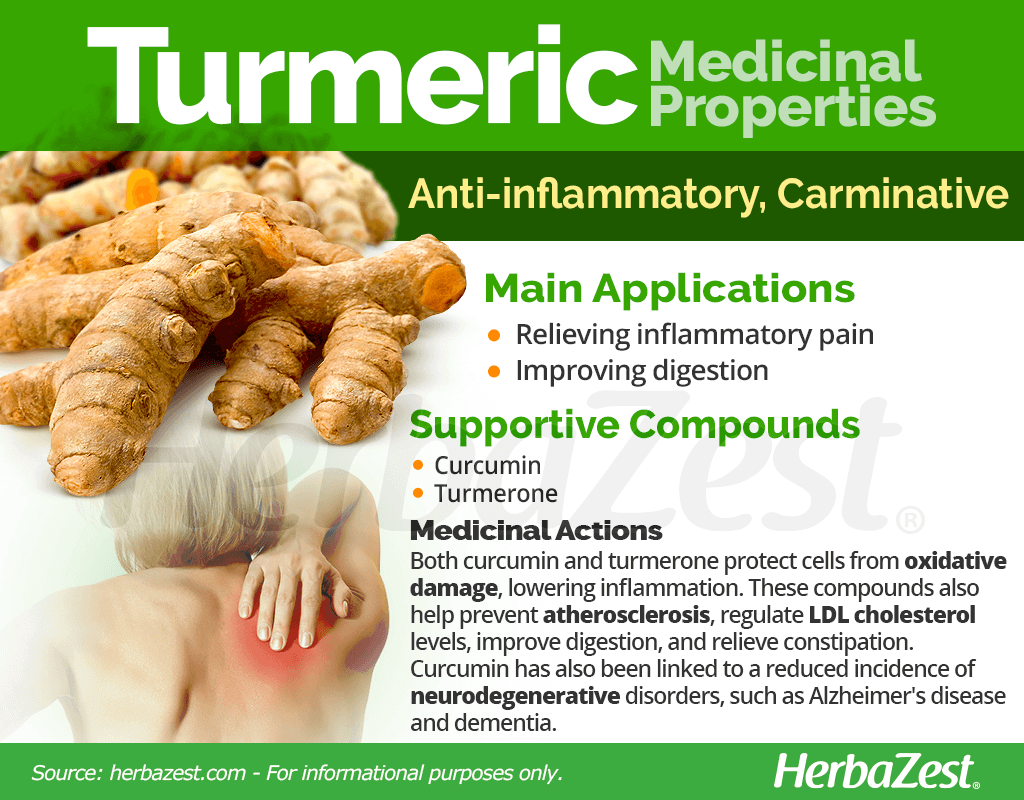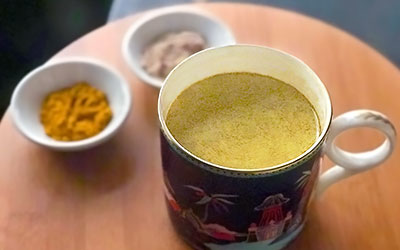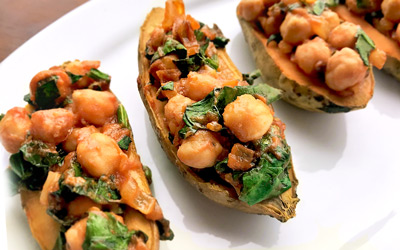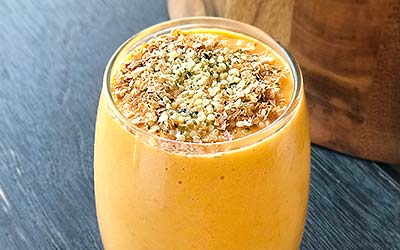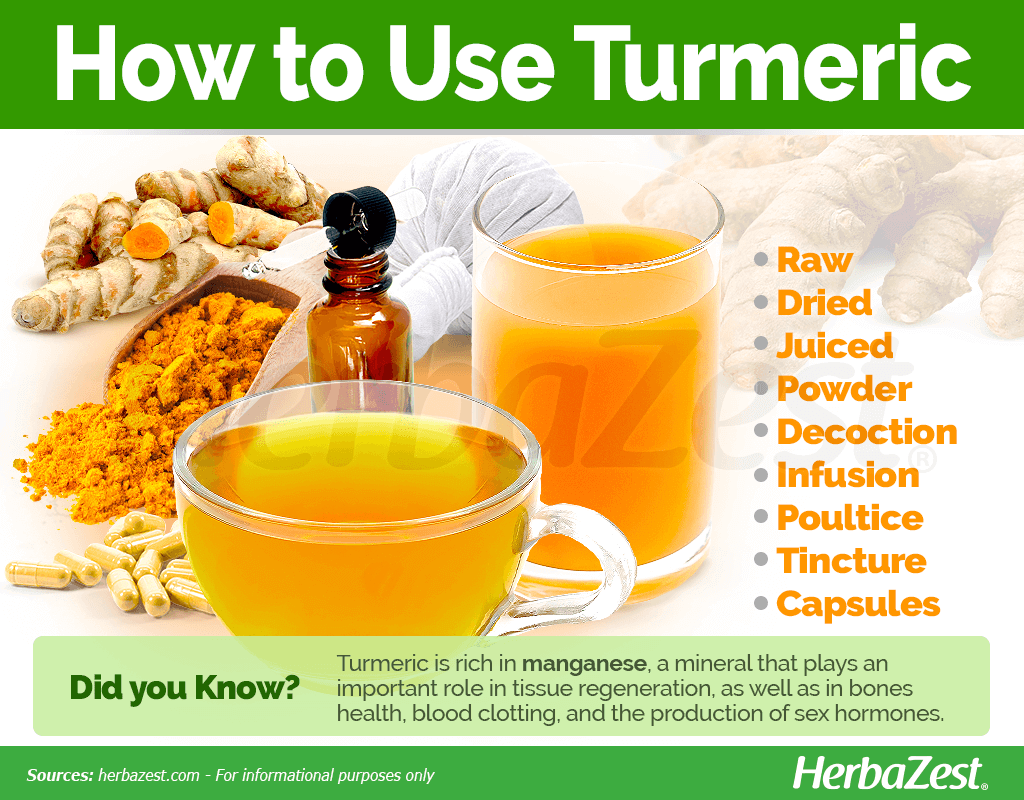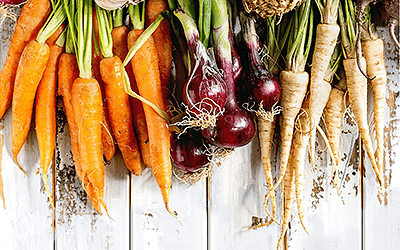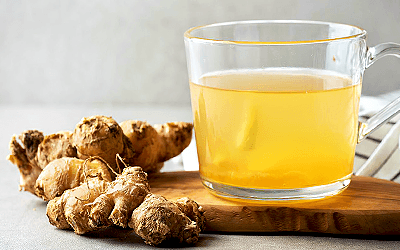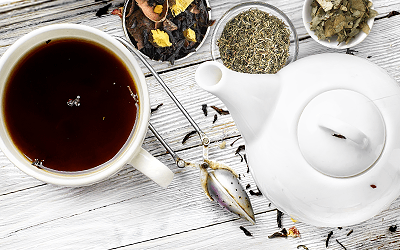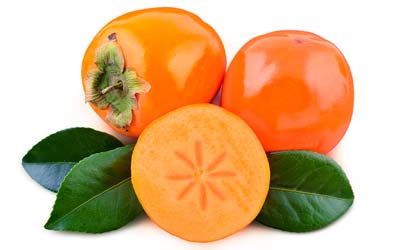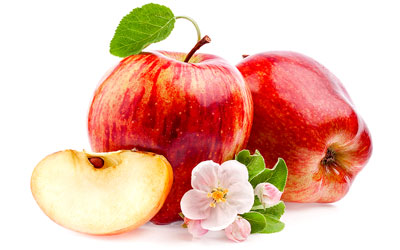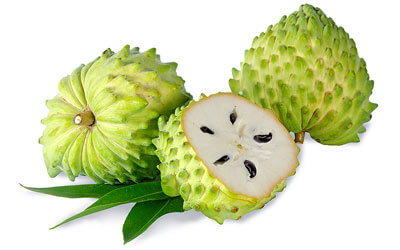One of the world's favorite spices, turmeric is a Southeast Asian native with an old and complex history: it has been used since time immemorial as a clothing dye and ritual purifier, especially among followers of Hinduism - a religious significance it still retains. Modern researchers have been able to trace turmeric benefits to its anti-inflammatory properties, while ongoing research is uncovering its ability to protect brain function and regulate cholesterol.
Turmeric Medicinal Properties
- Medicinal action Anti-inflammatory, Carminative
- Key constituents curcumin, turmerone
- Ways to use Decoctions, Tincture, Poultice, Powder
- Medicinal rating (5) Great value
- Safety ranking Safe
Health Benefits of Turmeric
Because of its long history of use, turmeric has found many different medicinal applications, some of which have been validated by modern science. They include the following:
Relieving inflamation. It has been found that turmeric tonic can improve scalp psoriasis, while turmeric polyherbal supplements have been shown to decrease facial redness due to rosacea.1,2
- Relieving osteoarthritic pain. A study has also shown that curcumin ointment can reduce knee pain in older adults suffering from knee osteoarthritis.3
Improving digestion. Turmeric has shown to speed up digestion and fight constipation. In fact, a recent study has found that turmeric is capable of improving human gut microbiota.4
Preventing the onset of dementia. New studies suggest some compounds in turmeric may protect the brain from aging-related damage, such as Alzheimer's disease or senile dementia.5
Lowering risk of cardiovascular disease. Turmeric seems to lower LDL cholesterol levels, and therefore may help prevent atherosclerosis.
How It Works
The main compounds behind turmeric's health properties are turmerone and curcumins. Turmerone, or ar-turmerone, is a ketone responsible for the largest share of turmeric's anti-inflammatory and neuroprotective effects. On the other hand, the better-known curcumin is a natural phenol that greatly complements the benefits of turmeric, as it possesses antioxidant properties, a savory aroma, and provides it with its distinctive yellow-orange or "golden" color. Other significant compounds and nutrients in turmeric include coumaric acid, zingiberones, and a minor amount of sugars and amino acids.
The full extent of turmeric's medicinal value lies in the combined action of its two main active ingredients. Turmerone is known to inhibit the production of pro-inflammatory cytokines, which lowers the effects of localized and systemic inflammation, protecting cells from related damage. At the same time, curcumin binds to amyloid proteins, a type of improperly-folded protein whose excessive accumulation is linked to neurodegenerative disorders. Together, both compounds can effectively reduce oxidation and protect hippocampal cells from toxicity. Furthermore, because they lower inflammation in the arteries as well, they are known to help with atherosclerosis prevention and to lower LDL cholesterol levels. Research on turmeric's cardiovascular effects is still ongoing, although it seems promising because of its lack of adverse reactions and low potential for toxicity.
Turmeric can inhibit inflammatory processes and may help delay neurodegenerative disease.
Anti-inflammatory, antioxidant properties are also present in persimmon, pumpkin and devil's claw, whereas clove, basil and dill provide similar carminative benefits.
Turmeric Side Effects
- Pregnancy and breastfeeding
- Gallbladder problems
- Slow blood clotting
- Surgery
Turmeric is likely safe for most people when taken in normal culinary amounts, and it seldom causes any side effects. In therapeutic doses, however, turmeric can cause indigestion, nausea, dizziness, or diarrhea.
In addition, some people with particularly sensitive stomachs or with Gastroesophageal Reflux Disease (GERD) may experience minor discomfort after eating foods with turmeric or curry.
Turmeric Nutrition
When used as a spice, turmeric not only provides the anti-inflammatory benefits of curcumin, but also high amounts of minerals like iron and copper, both crucial for the production and transport of red blood cells.
Even in culinary amounts, turmeric spice is incredibly high in manganese, a mineral that plays an important role in tissue regeneration, as well as in bones health, blood clotting, and the production of sex hormones. It also contributes to proper fat and carbohydrate metabolism, calcium absorption, and blood sugar regulation.
Additionally, turmeric is an adequate source of dietary fiber and magnesium, along with small quantities of many other minerals and vitamins, all of which contribute to its many nutritional benefits.
A single tablespoon of ground turmeric provides 29 calories and 8% of the recommended daily value for dietary fiber.
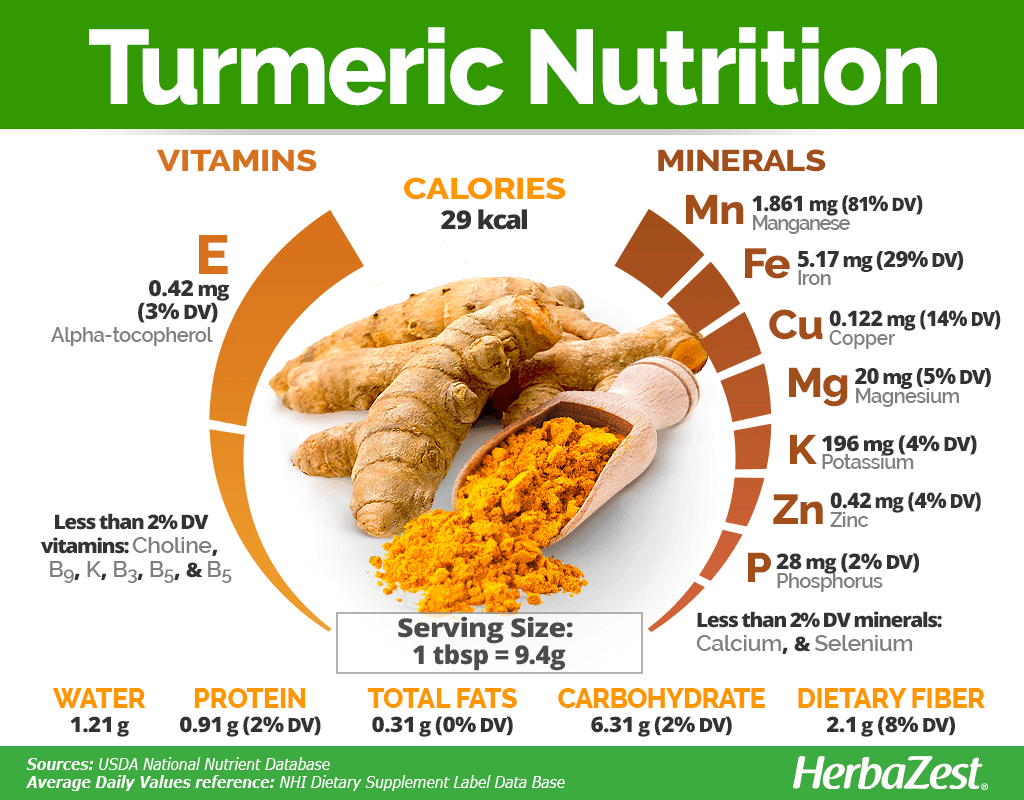
How to Consume Turmeric
- Edible parts Leaves, Root
- Edible uses Flavoring, Condiment
- Taste Mildly bitter, Earthy
Turmeric is popularly consumed as a flavoring and colorful addition in Indian and Thai dishes. However, the best way to reap its health benefits is in a variety of medicinal preparations.
Natural Forms
Raw. The fresh rhizomes or roots of turmeric can be grated and added to a wide variety of culinary dishes, or can be prepared into remedial forms.
Dried. Dried turmeric is often added to food or made into infusions, in order to add color and reap its medicinal properties.
Juiced. Fresh turmeric can be juiced, along with other vegetables and fruits, in order to extract its health benefits.
Powder. This is probably one of the most popular ways to use turmeric for culinary purposes, while taking advantage of its medicinal actions.
- Did you know?
Osteoarthritis patients should take ½ a cup of turmeric decoction, three times a day.
Decoction. By boiling the fresh or dry roots of turmeric, a liquid preparation can be obtained. This decoction can be drak to relieve pain and inflammation in a variety of health conditions, such as arthritis and stomach discomfort.
Infusion. A warm infusion is obtained by steeping the turmeric leaves or roots in hot water for few minutes. This preparation can be mixed with some coconut milk and black pepper in order to improve its pain relieving effects.
Poultice. The crushed rhizomes can be wrapped in a gauze and be applied topically over inflammated joints.
Best known for its use in curry dishes, turmeric's tangy and slightly spicy flavor has seasoned traditional Asian cuisine for thousands of years, most notably in India, Indonesia, and Vietnam.
Herbal Remedies & Supplements
Tincture. The crushed parts of the plant can be covered by a neutral alcohol and set aside for few weeks. This concentrated liquid needs to be diluted in water or other drinks in order to obtains its benefits.
Capsules. It is also possible to find concentrated turmeric supplements, mostly in capsules and tablets. The usual dosage is 500 mg, two to four times a day.
Growing
- Life cycle Annual
- Harvested parts Roots
- Light requirements Full sun
- Soil Light (sandy)
- Soil pH 6.1 – 6.5 (Slightly acidic)
- Growing habitat Subtropical regions
- Pre-germination seed treatment None
- Growing time 8 to 10 months
- Propagation techniques Root cuttings
- Potential insect pests Aphids, Mites
In countries with tropical climates, turmeric cultivation can be done year-round and with little difficulty. It is possible to grow this perennial root in temperate regions as well, but it will only flourish in summer months. Like its close relative, ginger, turmeric grows best in warm areas with ample precipitation, characteristic of tropical mountain climates.
Growing Guidelines
In order to flourish, turmeric requires temperatures between 70 - 85°F (21 - 30°C).
Turmeric planting is usually done from cuttings rather than from seed.
Plant each cutting around 10 inches (25 cm) apart.
In regions with rainfall below 59 inches (1,500 mm) per year, frequent watering will be required.
The plant requires 8 - 10 months to mature. Once it has drooped and withered, the rhizome is ready to be harvested.
Make sure to protect the turmeric plant from aphids and mites.
More detailed information about growing turmeric can be found in the herb garden section.
Additional Information
- Other uses Cosmetics, Dye
Plant Biology
Turmeric plants reach an average of three feet (90 cm) tall and feature long, tapered root-leaves and dull yellow flowers in germinating months. The root reaches 2 - 3 inches (5 - 8 cm) long and one inch (2.5 cm) wide, with a yellow exterior and a deep orange center. It is said to have a fragrant aroma straight from the ground.
Classification
A member of the Zingiberaceae family, turmeric (Curcuma longa) shares its tuberous characteristic with approximately 1,300 other aromatic flowering species distributed throughout tropical Africa, Asia, and South America. Other notable members of this family, considered staple spices around the world, are ginger (Zingiber officinale) and cardamom (Elettaria cardamomum).
Varieties and Cultivars of Turmeric
Approximately 30 different varieties of turmeric exist, differing in crop duration, nutritional content, and color concentration. 'Tekurpet' turmeric is said to have the most deeply hued rhizomes, good for tinting textiles, while 'Kasturi' and 'Kesari' types contain more curcumin, the root's antibacterial component. 'Mydukuru' turmeric offers great yield potential, but its medicinal quality is less valuable than that of other kinds.
Historical Information
The first evidence of turmeric use comes from residues found in pots discovered near New Delhi, which are at least 4,500 years old. The name turmeric seems to come from the Latin terra merita, which means merited earth. Ayurvedic texts, however, refer to turmeric with over 100 different terms.
Turmeric has been a staple of Ayurvedic remedies since 1900 BCE, mainly as a pain reliever and to lower fever. Information about turmeric's culinary uses did not reach Europe until after colonization, and the first mentions of this root in Western and European cuisine date back to 1747, in Hannah Glasse's The Art of Cookery Made Plain and Easy. It is estimated the first curry powders appeared around the same time; however, Western herbalists ignored its therapeutic potential until the first half of the 20th century.
Economic Data
Representing a substantial portion of spice trade worldwide, turmeric is of great importance to several countries as an exported material. India is particularly invested in its cultivation, producing 78% of the world's supply and counting the root among its top three spices sold abroad. The cultivation of turmeric is centered around Tamil Nadu, a region in the southern tip of India. Pakistan and other Asian countries also benefit financially from its growth, and new producers in Nigeria as well as the Caribbean are starting to plant the root on a commercial scale.
Popular Beliefs
Turmeric is seen as auspicious in Hindu culture. In southern India, some people wear pieces of the rhizome as an amulet against evil spirits.
Hindu and Buddhist religious ceremonies rely on turmeric for its cultural significance and association with spiritual rites, most notably in Hindu weddings, where it is traditional to cover both bride and groom in turmeric powder for purification purposes, in a ceremony known as the Biaha Haath.
Other Uses
Dye. Indian and Bangladesh clothing is often dyed using turmeric root powder, though the practice has not expanded commercially due to the dye's tendency to fade and run.
Cosmetics. Turmeric paste has been traditionally used in India to beautify skin and make it glow. Nowadays, it is added to sunscreen preparations.
Sources
- Encyclopedia of Herbal Medicine, p. 92
- MedlinePlus Herbs and Supplements, Turmeric
- NCCAM Herbs at a Glance, Turmeric: Science and Safety
- Encyclopedia of Natural Medicine, page 783
- International Immunopharmacology, Anti-inflammatory effects of aromatic-turmerone through blocking of NF-kB, JNK, and p38 MAPK signaling pathways in amylods β-stimulated microglia, 2012
- Journal of Alzheimer's Disease, Curcuminoid binds to amyloid - β1-42 oligomer and fibril, 2011
- Medicinal Herbs: A Beginner's Guide, pp. 94-8
- The Herbal Kitchen, pp. 106-8
Footnotes:
- Journal of Cosmetic Dermatology. (2018). Turmeric tonic as a treatment in scalp psoriasis: A randomized placebo-control clinical trial. Retrieved December 17, 2020 from https://pubmed.ncbi.nlm.nih.gov/29607625/
- Journal of Integrative Medicine. (2019). Dietary supplementation with turmeric polyherbal formulation decreases facial redness: a randomized double-blind controlled pilot study. Retrieved December 17, 2020 from https://pubmed.ncbi.nlm.nih.gov/30527287/
- Journal of Cosmetic Dermatology. (2018). Turmeric tonic as a treatment in scalp psoriasis: A randomized placebo-control clinical trial. Retrieved December 17, 2020 from https://pubmed.ncbi.nlm.nih.gov/30527287/
- Journal of Evidence-Based Integrative Medicine. (2018). Effects of Turmeric and Curcumin Dietary Supplementation on Human Gut Microbiota: A Double-Blind, Randomized, Placebo-Controlled Pilot Study. Retrieved December 17, 2020 from https://pubmed.ncbi.nlm.nih.gov/30088420/
- The American Journal of Geriatric Psychiatry. (2017). Memory and Brain Amyloid and Tau Effects of a Bioavailable Form of Curcumin in Non-Demented Adults: A Double-Blind, Placebo-Controlled 18-Month Trial. Retrieved December 17, 2020 from https://pubmed.ncbi.nlm.nih.gov/29246725/
